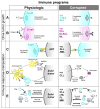Haematological malignancies: at the forefront of immunotherapeutic innovation
- PMID: 25786696
- PMCID: PMC4511812
- DOI: 10.1038/nrc3907
Haematological malignancies: at the forefront of immunotherapeutic innovation
Abstract
The recent successes of cancer immunotherapies have stimulated interest in the potential widespread application of these approaches; haematological malignancies have provided both initial proofs of concept and an informative testing ground for various immune-based therapeutics. The immune-cell origin of many of the blood malignancies provides a unique opportunity both to understand the mechanisms of cancer immune responsiveness and immune evasion, and to exploit these mechanisms for therapeutic purposes.
Figures


References
-
- Gattiker HH, Wiltshaw E, Galton DA. Spontaneous regression in non-Hodgkin’s lymphoma. Cancer. 1980;45:2627–32. - PubMed
-
- Del Giudice I, et al. Spontaneous regression of chronic lymphocytic leukemia: clinical and biologic features of 9 cases. Blood. 2009;114:638–46. - PubMed
-
- Feuerer M, et al. Bone marrow as a priming site for T-cell responses to blood-borne antigen. Nat Med. 2003;9:1151–7. - PubMed
Publication types
MeSH terms
Substances
Grants and funding
LinkOut - more resources
Full Text Sources
Other Literature Sources

